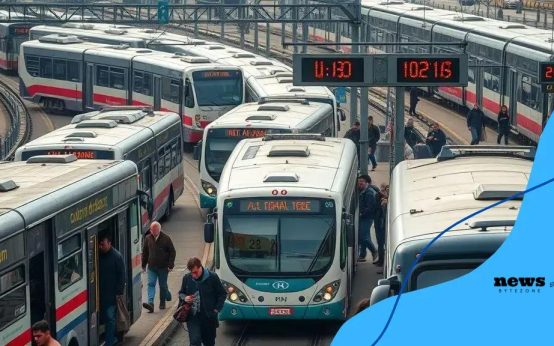Transportation subsidies enhance mobility for low-income workers by providing financial assistance for commuting costs, promoting access to jobs and opportunities while helping reduce economic strain.
Transportation subsidies: enhancing mobility for low-income workers is a crucial topic that affects thousands struggling to access jobs and resources. Have you ever considered how these subsidies shape daily lives?
Understanding transportation subsidies
Understanding transportation subsidies is key to appreciating how they can affect the lives of many individuals. These financial aids are designed to help people with limited incomes access reliable transportation options. By providing assistance, we open up new possibilities for job opportunities, education, and essential services.
Transportation subsidies come in various formats. They can be direct payments to individuals or discounts on transit fares. Many programs also offer reimbursement for travel costs related to employment or education. Understanding the specifics of these programs can make a significant difference in planning how to take advantage of them.
Types of Transportation Subsidies
There are several kinds of subsidies available for low-income workers that cater to different needs. Here are the most common types:
- Public transit fare discounts
- Taxi vouchers for urgent needs
- Carpool incentives for reduced commuting costs
- Reimbursement programs for travel expenses related to employment
Each subsidy type has unique benefits that can enhance mobility for low-income workers. For instance, public transit fare discounts can significantly cut down monthly expenses, while taxi vouchers can provide immediate access in critical situations.
Moreover, understanding eligibility for these subsidies is crucial. Many people might be surprised to find that they qualify for assistance. By researching local or state programs, applicants can uncover beneficial options they might not have initially considered.
Challenges Workers Face
Despite the advantages of transportation subsidies, many low-income workers face challenges in accessing them. Some common hurdles include a lack of awareness about available programs, complicated application processes, and limited funding for specific initiatives.
As communities strive to enhance mobility, acknowledging these challenges is vital. By working towards simplifying application processes and increasing public awareness, we can ensure that more low-income workers benefit from transportation subsidies.
Impact on low-income workers
The impact on low-income workers from transportation subsidies is significant. These financial aids can transform daily commutes and access to jobs. For many, reliable transportation is the key to employment opportunities.
Transportation subsidies help low-income workers reduce their travel costs. With lower expenses for commuting, they can allocate more money toward essential needs like housing and food. Many workers find that with the help of these subsidies, they can afford to travel to jobs that were previously out of reach.
Benefits of Transportation Subsidies
Low-income workers enjoy several advantages from transportation subsidies:
- Improved job access: Subsidies allow workers to reach employers who are farther away, increasing job options.
- Increased mobility: With reliable transportation, workers can attend interviews, training programs, and other essential activities.
- Economic stability: Having a stable job leads to financial security, which positively affects families and communities.
- Time savings: Subsidies can contribute to shorter travel times, giving workers more time for family and self-care.
The ripple effect of these benefits creates a more productive workforce. When transportation options are accessible, workers feel empowered. They are more likely to accept jobs that match their skills, leading to overall economic growth.
However, challenges persist. Many low-income workers may still experience barriers when trying to access these subsidies. Some might not know they qualify or may find the application process daunting.
Addressing the Barriers
To maximize the benefits of transportation subsidies, it’s essential to tackle these issues head-on. Community organizations can play a significant role by helping workers understand their options. Outreach programs that educate individuals about available subsidies can bridge the gap.
Eliminating barriers is crucial for ensuring that transportation subsidies serve their purpose. By increasing awareness and simplifying the application process, we can enhance access for low-income workers, providing them the support they need to thrive.
Different types of transportation subsidies

There are different types of transportation subsidies available to help low-income workers access reliable transportation. Each type serves a unique purpose and provides specific benefits to those who qualify. Understanding these options can empower individuals to take advantage of resources that make commuting easier.
Transportation subsidies generally fall into a few main categories. These include direct payments for travel, programs offering reduced fares, and incentives for using environmentally friendly transport options.
Key Types of Transportation Subsidies
Here are some common types:
- Public transit fare discounts: Many cities offer reduced rates on buses and trains for eligible individuals. This helps lower monthly commuting costs and encourages public transportation use.
- Taxi and rideshare vouchers: Programs that provide vouchers for taxis or rideshare services are crucial for urgent travel needs when public transport is not available.
- Bicycle incentives: Some organizations promote biking by offering subsidies for purchasing bicycles or bike accessories. This not only aids individuals but also supports environmental initiatives.
- Carpool programs: Incentives for those who share rides can minimize costs and encourage community bonds among workers commuting in the same direction.
Each type of subsidy has a specific eligibility criterion. It’s important for potential applicants to research local offerings. Sometimes, subsidies can even be combined, enhancing the overall benefit for users.
Additionally, some subsidies may focus on particular groups, such as veterans or part-time workers. This targeted approach can help those who might otherwise struggle to access transportation.
Impact of Subsidy Types
The variety of transportation subsidies can significantly affect low-income workers’ lives. When these resources are available and accessible, they lead to increased job opportunities and better overall quality of life. By providing the essential means to get to work and other crucial activities, these subsidies promote economic stability.
Not only do transportation subsidies enhance mobility, but they also encourage a healthier lifestyle by supporting options like biking or using public transport. The goal is to create a seamless commuting experience that helps those in need.
Challenges in implementing subsidies
Although transportation subsidies offer important benefits, there are challenges in implementing subsidies that can hinder their effectiveness. These obstacles can prevent low-income workers from fully benefiting from the programs designed to support them.
One major challenge is awareness. Many eligible individuals do not know about the subsidies available to them. This lack of information can lead to missed opportunities and continued financial strain. Efforts must be made to ensure that all potential beneficiaries are informed about what subsidies exist and how to access them.
Common Obstacles
Several key obstacles can limit the impact of transportation subsidies:
- Complex application processes: Some programs have lengthy and complicated applications that can discourage low-income workers from applying.
- Limited funding: Many subsidy programs operate with restricted budgets, resulting in caps on how many people can receive assistance.
- Inconsistent program availability: Changes in government policies can cause fluctuations in the availability of subsidies, leading to confusion among workers.
- Transportation infrastructure issues: In some areas, the lack of efficient public transportation options makes subsidies less effective.
Another challenge is the stigma that can be associated with receiving assistance. Some individuals may feel hesitant to apply for subsidies due to perceptions that they may be seen as relying on government support. This can lead to a reluctance to seek help when it is genuinely needed.
Strategies for Improving Access
To address these challenges, stakeholders must collaborate to create streamlined processes. Simplifying applications and increasing outreach can help more low-income individuals access crucial transportation subsidies. Encouraging community organizations to provide support and guidance can also alleviate some of the burdens faced by applicants.
Finally, continuous feedback from users of these programs can assist in making necessary adjustments. By listening to the experiences of low-income workers, authorities can fine-tune programs to better meet the needs of the community.
Future of transportation subsidies
The future of transportation subsidies holds exciting possibilities as communities strive to improve mobility for low-income workers. With the ongoing focus on sustainability and accessibility, various initiatives are being developed to adapt to the changing needs of the workforce.
One significant trend is the growing emphasis on green transportation options. As cities aim to reduce their carbon footprints, subsidies may increasingly support cycling and public transport over traditional vehicle use. This shift not only benefits the environment but also enhances social equity by making commuting more affordable.
Innovative Approaches
Several innovative approaches are emerging in the realm of transportation subsidies:
- Mobility-as-a-Service (MaaS): This concept integrates multiple transportation services into a single accessible platform, allowing users to plan and pay for their trips seamlessly.
- Dynamic subsidies: Future programs may adapt funding based on real-time needs, offering more significant support during peak demand times.
- Collaboration with employers: Partnerships between government and businesses could lead to customizable subsidy offerings that align with specific workforce requirements.
- Focus on technology: Advancements in technology can help facilitate access to subsidies, making the application process smoother through mobile apps and online platforms.
As cities continue to evolve, the role of transportation subsidies will change. Policymakers will need to remain flexible and innovative to meet the demands of the population effectively. By prioritizing user feedback and monitoring observable results, communities can ensure that subsidies remain impactful.
Moreover, addressing the unique needs of different demographic groups, including the elderly and disabled, will be essential. Tailoring transport solutions for various communities could enhance accessibility, ensuring that no one is left behind in mobility improvements.
FAQ – Frequently Asked Questions about Transportation Subsidies
What are transportation subsidies?
Transportation subsidies are financial aids designed to help low-income workers cover the costs of commuting, making transportation more affordable.
How can I apply for transportation subsidies?
You can apply for transportation subsidies through local government programs or nonprofit organizations that offer assistance to eligible individuals.
What types of transportation subsidies are available?
Common types of transportation subsidies include public transit fare discounts, taxi vouchers, bicycle purchase incentives, and carpool programs.
What challenges do people face when accessing transportation subsidies?
Challenges can include a lack of awareness about available subsidies, complex application processes, and limited funding for certain programs.

 PublicTransportAid: Enhance Your Commute Experience Today
PublicTransportAid: Enhance Your Commute Experience Today  Maximize Your Savings: Navigating the Healthcare Benefits Enrollment Period
Maximize Your Savings: Navigating the Healthcare Benefits Enrollment Period  Maximize Your Savings: Navigating the New Healthcare Enrollment
Maximize Your Savings: Navigating the New Healthcare Enrollment